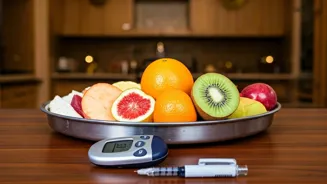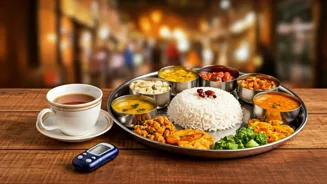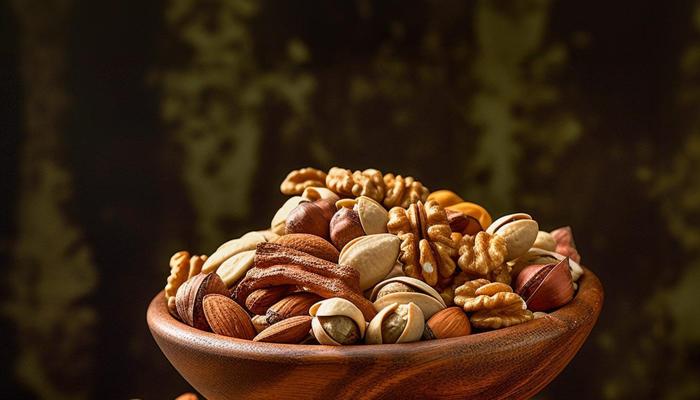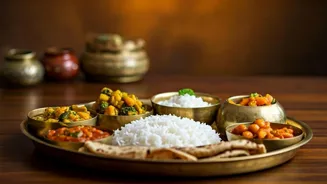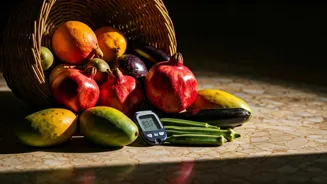Unraveling the Glycemic Index: Key Insights for Healthier Choices. Discover the impact of food on blood sugar levels
In a nation where diabetes is increasingly common, understanding how food affects our
blood sugar levels is becoming more important than ever. The Glycemic Index (GI) is a tool that helps us do just that.
It ranks carbohydrates on a scale of 0 to 100, based on how quickly they cause blood sugar levels to rise after eating. Think of it like a speed meter for sugar – how fast a particular food sends sugar rushing into your bloodstream.
Knowing these facts can help you make smarter food choices and manage your health better.
Glycemic index measures food's impact on blood sugar
The Glycemic Index (GI) measures how quickly a food raises blood sugar levels compared to pure glucose, which has a GI of 100. Foods with a low GI (55 or less) are digested and absorbed slowly, causing a gradual rise in blood sugar.
These are often considered better choices for overall health and especially helpful for people managing diabetes. High GI foods (70 or more) cause a rapid spike in blood sugar, which can lead to energy crashes and potential health problems over time.
It is important to know the GI of your frequently taken food.
Glycemic Load crucial for balanced eating, not just Glycemic Index
One crucial point is that the GI isn't the be-all and end-all of healthy eating. It only tells you how quickly a food affects your blood sugar, not how much carbohydrate it contains. This is where Glycemic Load (GL) comes in.
GL considers both the GI of a food and the amount of carbohydrate it contains in a typical serving. So, a food might have a high GI, but if you only eat a small portion of it, the impact on your blood sugar may be minimal. Opt for low GI options that help in slow digestion.
Food GI values vary due to ripeness, cooking, and processing
The GI value of a food isn't set in stone. It can change based on several factors. For example, how ripe a fruit is can affect its GI. A ripe banana will have a higher GI than a greener one. Cooking methods also play a big role. Boiling vegetables can often lower their GI compared to frying.
Even processing can make a difference - whole grains usually have a lower GI than refined grains. So, it's best to think of GI values as a general guide rather than an absolute rule. Don't rely on a single reading; know the factors that affect it.
Food prep methods and ripeness impact glycemic index
The method of food preparation, like baking or boiling, can impact the GI. For example, a baked potato typically has a higher GI than a boiled potato because baking can break down the starches faster.
Similarly, the ripeness of fruits affects their GI, with riper fruits generally having a higher GI due to increased simple sugars. Knowing these factors helps you make more informed decisions when preparing your meals.
It also shows that relying solely on standardized GI tables might not always provide the most accurate picture of how a food will affect your blood sugar.
Different foods' GI varies; choose wisely for blood sugar control
The variety of the particular fruit or vegetable can also influence its GI. Different types of rice, for example, have varying GI values depending on their starch composition and the way they are processed.
Basmati rice, known for its long grains, generally has a lower GI compared to some other varieties. Similarly, different types of potatoes can vary in their GI based on their starch content and texture.
Considering these nuances allows you to tailor your food choices to better manage your blood sugar levels, especially if you have diabetes or are at risk of developing it.
Fiber-rich foods stabilize blood sugar levels
Foods high in fiber tend to have a lower GI. The fiber slows down the digestion of carbohydrates, which means the sugar is released into your bloodstream more slowly.
Whole grains, legumes (like beans and lentils), most vegetables, and fruits with edible skins are all good sources of fiber and generally have a lower GI. Including plenty of these foods in your diet is a great way to stabilise your blood sugar levels and keep you feeling full for longer.
Soluble fiber in foods slows glucose absorption, aids weight management
Foods rich in soluble fiber, like oats and apples, are particularly effective in slowing down glucose absorption. Soluble fiber forms a gel-like substance in the digestive tract, which delays the emptying of the stomach and the subsequent release of sugar into the bloodstream.
This not only helps to prevent spikes in blood sugar but also promotes a feeling of fullness, which can aid in weight management. Additionally, fiber promotes healthy digestion and can help lower cholesterol levels.
Easy ways to increase fiber intake for better health
Adding fiber to your meals is easy and versatile. Start your day with a bowl of oats instead of refined cereals. Incorporate lentils and beans into your dals and curries. Choose whole-wheat bread and pasta over their white counterparts. Snack on fruits and vegetables with their skins intact.
Simple changes like these can significantly increase your fiber intake and help you maintain stable blood sugar levels throughout the day, leading to improved overall health.
Combining protein/fats with carbs lowers glycemic impact
While the GI focuses on carbohydrates, it's important to remember that how you combine foods can also affect your blood sugar. Adding protein or healthy fats to a carbohydrate-rich meal can slow down the digestion process and lower the overall glycemic impact of the meal.
For example, having a chapati with dal and vegetables is better than having just a chapati and adding ghee. The protein and fat in the dal and vegetables help to moderate the release of glucose.
Protein and fat slow carb digestion, stabilize blood sugar
Protein and fat slow down the digestion of carbohydrates by delaying gastric emptying. This means that the carbohydrates are released into the small intestine, where they are absorbed, at a slower rate.
The slower absorption rate leads to a more gradual rise in blood sugar levels, preventing sharp spikes. Including sources of lean protein like paneer or tofu, along with healthy fats from nuts, seeds, or avocados, in your meals can improve blood sugar control and promote satiety.
Include protein and fats in meals for balanced nutrition
Consider including protein and fat-rich foods in your main course dishes. When eating fruit, pair it with a handful of nuts or a spoonful of peanut butter for a more balanced snack. In your main meals, ensure that you have a good balance between carbohydrates, protein, and fats.
This approach is particularly beneficial for people with diabetes or insulin resistance, as it helps to stabilize blood sugar levels and maintain steady energy throughout the day.
Portion control vital for managing blood sugar
Even if a food has a low GI, eating a large portion of it can still lead to a significant rise in blood sugar. Remember Glycemic Load (GL). GL takes into account both the GI and the amount of carbohydrate in a serving.
A large serving of a low GI food can have the same (or even a higher) impact on your blood sugar as a small serving of a high GI food. So, portion control is key, regardless of the GI of what you're eating. It all starts with having a balanced serving size.
Eating smaller portions with low GI for stable blood sugar
Eating a smaller portion of food, even if it has a moderate GI, reduces the total amount of carbohydrates consumed in one sitting. This translates to a more manageable rise in blood sugar levels.
For example, if you are eating rice, limit your serving to a small bowl and pair it with plenty of vegetables and a moderate amount of protein. This combination helps to balance the meal and minimize the overall impact on your blood sugar.
Smaller plates control portions for healthier eating habits
Using smaller plates and bowls can help you naturally control portion sizes. Pay attention to your hunger and fullness cues, and stop eating when you feel satisfied, not stuffed. Avoid mindless eating by removing distractions like television and phones during meal times.
Practicing mindful eating helps you to better recognize your body's signals and make more conscious choices about how much to eat. Paying attention to the portion size is hence a first step to healthy eating habits.
GI is a tool, focus on balanced diet, not just GI
The GI is a useful tool, but it's important not to get too hung up on it. It's just one piece of the puzzle when it comes to healthy eating. Focus on eating a balanced diet that includes plenty of fruits, vegetables, whole grains, lean protein, and healthy fats.
Don't eliminate foods based solely on their GI. Consider the overall nutritional value of the food and how it fits into your overall diet.
Personalized dietary guidelines with healthcare professionals
Dietary guidelines should be highly personalized and developed in consultation with healthcare professionals like dieticians or nutritionists. A registered dietitian or nutritionist can help you personalize your dietary approach based on your health status, lifestyle, and preferences.
This may involve taking into account the GI/GL of foods, but also considering nutrient density, overall caloric intake, and individual sensitivities.
Healthy diet and exercise for optimal health and well-being
Remember that a healthy diet is not about restriction. It is about balance, diversity, and enjoying your food. Incorporate regular physical activity into your routine, as exercise can improve insulin sensitivity and help regulate blood sugar levels.
By combining healthy eating habits with regular exercise, you can achieve optimal health and well-being, regardless of your specific needs. All these factors together make for a healthy approach. Remember that lifestyle is important in maintaining sugar levels in your body..
Five key facts about Glycemic Index for better health choices
So, there you have it! Five important facts about the Glycemic Index that can help you make better food choices and manage your health more effectively. Remember to use the GI as a guide, not a strict rulebook, and focus on eating a balanced and varied diet.
AI Generated Content. Glance/InMobi shall have no liability for the content


